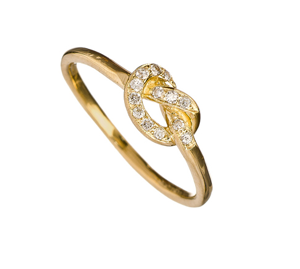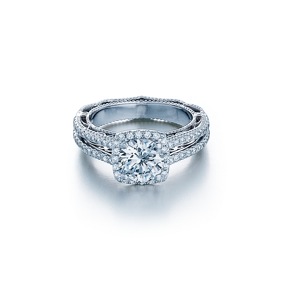Articles and News
TREND TO WATCH: CHALLENGES AHEAD FOR BRIDAL JEWELRY? | November 16, 2011 (2 comments)

Merrick, NY—The tried-and-true way to sell an engagement ring typically is to start at the top and work down. One of the first training lessons for sales associates is to shift the couple’s attention away from price.
“Let’s put price aside for a moment and focus on the style you like, then we’ll find something in your price range,” or something similar, is the standard drill, in the hopes that the couple will want a ring more expensive than their stated budget and decide to stretch for such a significant once-in-a-lifetime purchase.
But recently small signs have begun to suggest this may be changing. Between rising diamond and metal prices, a difficult economy, and changing social mores, some couples are rethinking the traditional path of engagement, marriage, and children. Some are delaying—or simply forgoing—traditional marriage and living together without the ceremony, as evidenced by a 13% rise in unmarried, opposite-sex, cohabiting couples reported in the 2010 U.S Census. Others are opting for marriage but scaling back on the lavish wedding and putting their money toward a home or other practical considerations, while still others are even scaling back on the big diamond and opting for a non-traditional—and less expensive—ring.
It’s still a nascent trend and one that may ultimately prove to be nothing more than a tempest in a teapot. But the growth of contemporary metal wedding bands and the Millennial generation’s emphasis on individuality both signal consumer willingness to bend tradition. And when even a powerhouse like Blue Nile says it’s finding unprecedented challenge in the bridal market, it’s worth at least keeping a wary eye on it. In this article in National Jeweler, the e-tailer’s CFO David Binder said he sees the engagement market declining, both in terms of the product spend and the number of marriages.
Though still a minuscule portion of total bridal jewelry sales, an article in the Financial Times says the demand for non-traditional engagement rings has grown from an anomaly to being enough to sustain a few collections. For example, designer Rosanne Karmes of Sydney Evan told FT a diamond pave disco ball she initially designed as a riff on the traditional solitaire sold as an engagement ring, as has a ring with “love” spelled out in diamond pave, and when a price-conscious couple asked jeweler Ariel Gordon to add diamonds to her Love Knot ring, she realized it was a viable design for an affordable engagement ring.
The designer, whose Love Knot rings ($75 in sterling silver; $125 in 14k gold without diamonds) have been spotted on celebrities like Jessica Biel and Drew Barrymore and featured in popular fashion magazines like Lucky that target the 25-34 demographic, added a pave version that bumps her price point up to $400-$485. But because of her designer name and the celebrity/fashion association, it’s got a cachet that belies its very modest price.
Also, as same-sex marriages become legalized in more places, demand for suitable rings—some traditional, some not—also is rising, and designers such as Love and Pride’s Udi Behr have carved a niche serving same-sex couples. Meanwhile, a new website, babydaddy.com, offers up rings for unmarried but committed parents.


Ariel Gordon’s Love Knot ring, left, with diamond pave appeals to stylish but budget-conscious couples as an affordable engagement ring priced under $500. From Love and Pride, right, an 18k white gold engagement ring with love and peace symbols, retailing for $3,995.
Blue Nile founder Mark Vadon cited the tough job market that’s hit younger consumers hard as one reason for the e-tailer’s decision to invest in growing its non-bridal jewelry categories. The lack of both employment and credit for these younger workers means fewer are in a position to buy the diamond of their dreams. Indeed, this article on CBSNews.com says the unemployment rate for workers age 25-34—prime first-marriage age—was 9.5% in August, compared to 6.6% for workers over age 55.
As even a micro-trend, it seems to be of less concern for affluent couples and, by extension, prestige jewelers. The typical engagement ring spend at a luxury jewelry store is about $7,000, more than double the industry average of $3,350 in 2010. But as diamond and metal prices climb, even luxury jewelers may start to feel the pinch.
GIA senior industry analyst Russell Shor has been voicing concern about rising diamond prices for some time. “When a couple has $5,000 to spend on an engagement ring, if prices keep rising they may come to a point where they see how little [diamond] their money buys, and they may opt for color, or just skip the ring altogether,” he told The Centurion.
Kevin Byler of Elleard B. Heffern in St. Louis, MO told The Centurion he’s less concerned about whether customers want color or an alternative style for an engagement ring—he’s had only one recent request, for a sapphire—than whether they’re simply not coming in the door.
“Engagement rings are a touchy issue, because the guy wants to get her what she wants; he doesn’t want to start off by saying no. But we’re a third-generation jeweler and maybe the couple is hesitant to come in because they think they won’t see anything [they can afford]. So maybe they just don’t come in.” His typical price point for an engagement ring starts between $7,000 and $8,000. He says $10,000 is a pretty standard dividing line for engagement ring sales at the store—first marriages, it’s below; second, it’s above.
Often, he says, the man will come and choose the stone, but leave the setting choice to his fiancée. But that poses a whole other set of issues if he’s chosen a $10,000 stone on a $12,000 budget, when many settings are $5,000 to $6,000 without the stone.
One megatrend in bridal jewelry is the halo setting, which offers a big-rock look for a lower price than a comparable-size solitaire and has become tremendously popular. But don’t automatically assume it’s going to be an inexpensive alternative, warns Byler, especially if the setting has to be remade to fit the stone. “If you have a halo mounting designed for a 7mm diamond and yours is 7.1mm, the entire thing has to be remade,” he says. Some halo settings may have enough space between the stones to allow for small adjustments, but if the diamonds are very close together with no space—as his rings are—they can’t be moved.

A halo-set ring from Verragio.







